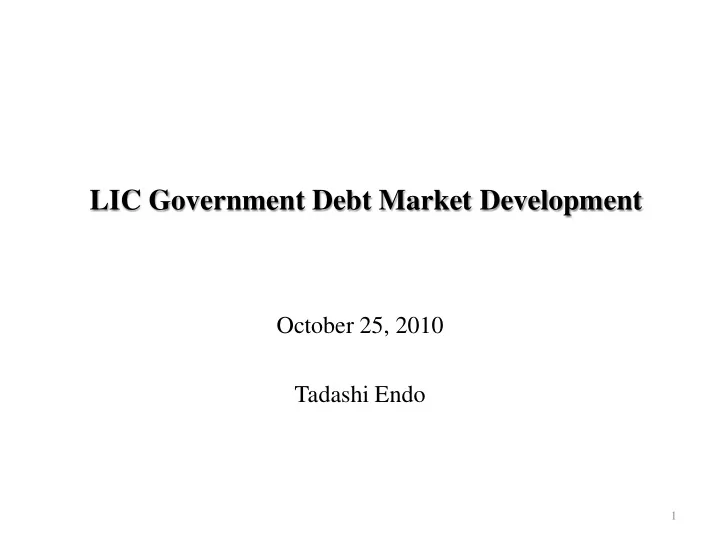

LIC Government Debt Market Development October 25, 2010 Tadashi Endo 1
Reasons for a LIC Framework Gov’t/ Mkt Microstructure Stakeholders “Phantom liquidity” in Observa- Rarely Many and tions implemented market making diverse parties (continuous market) with local relationships “Weak” Causes Capacity High costs associated with constraints low liquidity through institutional negative feedback loops framework (NFLs) Proposed Incremental Grow out of NFLs by Stakeholder solutions approach making the most of management ▼ liquidity available in the through “champions” Four-stage market (combination of approach right microstructures) 2
Advanced Market Observations Were Reduced into Sound Practices. More reduction than deduction Market development model based on ex post facto observations Highly More deduction than reduction advanced Market development model based on markets ex ante facto projections Middle-income countries Low-income countries 3
Flexible Application of Four-stage Approach IV (Highly Stage I (Nascent) II (Advancing) III (Advanced) advanced) Investor base Generally consistent and congruous Generally consistent and congruous Generally consistent and congruous Generally consistent and congruous Sound Practices Policy theme Accounting Legal Primary market Debt management (DM) Secondary market Money market Derivatives/Futures Clearing & settlement 4
Dealer “Club” (Agency) Market, Call Action Market, and Partial Market Making in The Secondary Market Dealer club Cost of setting up and market running and organized market, etc. Trading cost Ignored or overlooked market-risk cost, etc Call market Full-scale market making market Partial market making market Nascent Advancing Advanced Highly advanced emerging emerging emerging emerging market market market Development Stages of Emerging Markets 5
Why Stakeholder Dynamics? • Local relationships among stakeholders • “Weak” institutional frameworks • “Champions” – Identify a market development champion – Identify the most useful stakeholders – Steer the interests of stakeholders Other Commercial commer High-level Policy Bank of High cial Highly advanced Ethiopia Makers banks market Academia MOF Pension Fund Depositors LIC market Subjects Players Creditors Central Bank Insurance SOEs Companies State-owned Donors Commercial Banks Same or different Govt funds Interest stakeholders with differing degrees of Development Commercial Banks High-level IMF MOF power and Institutions NBE policy maker Minister competence. Mass Media NBFIs Note: This diagram is Crowd Context Setters based on the authors' National Securities Market Retail Investors subjective valuations University Regulator Instiutional Professors but not on objective Legistrators Press Investors measurements. Low Low Power High
Recommend
More recommend